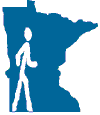What were things like in 2002?
The following idicator summary is from the 2002 Minnesota Milestones and does not neccessarily reflect the current data trends.
Indicator : Post-high school education and training
Rationale: Tracking the status of high school graduates provides an indication of how many are preparing themselves to enter the workforce with advanced skills.
About this indicator: The trend is difficult to discern because of changes in the way the information is collected. In a 2000 follow-up survey, 86 percent of 1997 graduates said they had enrolled in college. In the earlier one-year follow-up surveys conducted from 1990 to 1996, between 70 and 75 percent of high school graduates had pursued advanced training, apprenticeships or higher education one year after finishing high school.
Data from the Minnesota Higher Education Services Office suggests that 43 percent of Minnesota high school graduates in 2000 attended a Minnesota post-secondary institution the following fall. In addition, the Minnesota Higher Education Services Office estimates that approximately 15 percent of Minnesota high school graduates attended out-of-state post-secondary institutions in 2000, based on data from the National Center for Education Statistics. Adding these figures would show that 58 percent of Minnesota's 2000 high school graduates attended college the following fall, a significantly smaller portion than the Department of Children, Families & Learning found.
Percentage of high school graduates pursuing advanced training, apprenticeships or higher education one year after high school
Percentage of high school graduates pursuing advanced training, apprenticeships or higher education one year after high school
| Year | Data |
|---|
| Percentage of high school graduates pursuing advanced training, apprenticeships or higher education one year after high school, Minnesota Department of Children, Families & Learning
|
|
2000 |
86% |
For comparison: According to the Bureau of Labor Statistics, in 2000, approximately 63 percent of high school graduates throughout the country went to college the following fall. The Bureau of Labor Statistics does not provide similar state level data.
Things to think about: A prerequisite for increasing the percentage of students going on to college is increasing the number of students taking appropriate high school courses. The ACT-recommended college preparatory curriculum is four years of English and three years each of science, social science and math. Of the Minnesota high school students taking the ACT college entrance examination in 2001, approximately 67 percent had taken the recommended curriculum. This is down from 71 percent in 1999. Raising the percentage of high school students taking the college preparatory classes may lead to a higher percentage of students entering college following graduation.
Technical notes: In
Minnesota Milestones 1998, this indicator was based on a one-year follow-up survey of high school graduates. Starting in 1997, the Minnesota Department of Children, Families & Learning replaced that survey with a two-stage survey: first, a survey of high school seniors about their fall plans after graduation (work, college, apprenticeship, military or a combination of these options) and second, a follow-up survey three years later. This was conducted in 2000.
The 1997 survey included a sample of 1,775 high school seniors. For the three-year follow up survey in 2000, responses were obtained from 636 of the original 1,775. The data suggests that students enrolled in college were more likely to respond to the survey, biasing the indicator upward.
The Minnesota Higher Education Services Office suggests that the college residence data provided by the National Center for Education Statistics should be used cautiously due to the fact that some institutions do not report their results.
Sources:Minnesota Department of Children, Families & Learning, Class of 1997 Three-Year Follow-Up, http://cfl.state.mn.us/
Minnesota Higher Education Services Office and Minnesota Department of Children, Families & Learning, 1999 Minnesota High School Follow-Up Survey, www.mheso.state.mn.us
U.S Department of Education, National Center for Education Statistics, Digest of Education Statistics, 2000, Residence and Migration of First-time Freshmen, http://nces.ed.gov/pubs2001/digest/dt205.html
U.S. Bureau of Labor Statistics, College enrollment and work activity of year 2000 high school graduates, www.bls.gov
Pioneer Press, “Minnesota kids boost test scores,” 15 August 2001.
Related 2002 Milestones indicator:
Local data:


Milestones is a product of the Minnesota State Demographic Center, a division of the Department of Administration





